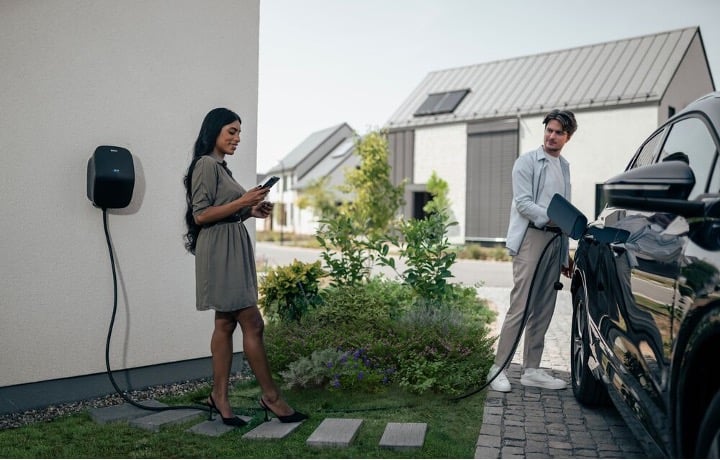
Last updated 14-07-2023
Level 3 charging, also called fast charging or DC charging, is the most powerful electric vehicle (EV) charging standard, unlocking much faster charging speeds than other levels of charging (AC) regular AC charging.
When using a Level 3 charging station (DC fast charging), the average time it takes to charge a medium-sized electric car lies somewhere between 17 and 52 min.
However, there are many factors that can affect charging speed. In this article we aim to explain how Level 3 charging works and explain the most common factors that affect Level 3 charging speed.
Table of contents
Fast-charging knowledge, there’s levels to it

If you’ve researched electric vehicles (EVs), you might have heard the terms Level 1, Level 2, and Level 3 charging floating around in relation to charging speeds. Level 3 charging, also known as DC fast charging, is the fastest way to charge an EV, topping up most vehicles in just minutes as opposed to hours with regular AC charging.
Put simply, Level 3 charging delivers more power, faster, making it ideal for on-the-go locations like gas stations or highway rest stops. Given the high-voltage supply required for Level 3 charging (and their much higher price point), you won’t see DC fast chargers installed in residential locations—they’re much better suited for commercial locations with a sufficient power supply.
So, how fast is Level 3 charging really? And what factors affect charging speed? In this article, we’ll introduce everything you need to know about the speed of Level 3 chargers and provide a comprehensive overview of the factors that impact it.

How long does it take to charge an electric car with level 3 charging?
With different types of vehicles and batteries, a variety of fast-charging stations with numerous power outputs, and a handful of factors that can affect charging speed, it is impossible to provide a single answer. In this article we aim to explain how Level 3 charging works and explain the most common factors that affect Level 3 charging speed.
However, before we dive into detailed explanations, we can give you an estimate of how long it takes to fast charge vehicles per type of vehicle (based on average battery size) and level of power output.
In a nutshell: When using a Level 3 charging station (DC fast charging). The average time it takes to charge a medium-sized electric car lies somewhere between 17 and 52 min.
How fast does a Level 3 charger charge?
|
Power output charging station |
Small EV |
Medium EV |
Large EV
|
|
50 kW |
32 min |
52 min |
1h12m |
|
100 kW |
16 min |
26 min |
36 min |
|
150 kW |
- |
17 min |
24 min |
|
240 kW |
- |
11 min |
15 min
|
|
300 kW |
- |
8 min |
11 min |
|
Approximate time to charge the battery from 20 percent to 80 percent state of charge (SoC). For illustrative purposes only: Does not reflect exact charging times, some vehicles will not be able to handle certain power inputs, and/or do not support fast charging. |
|||
How do EV charging stations work?
To understand Level 3 charging speeds, it’s important to get a basic understanding of how EV charging works. One of the main factors that differentiate Level 3 charging from the other levels is the type of current it uses.
Where Level 1 and Level 2 charging stations provide Alternating current (AC), Level 3 stations provide Direct current (DC).
Let’s take a closer look at the differences between AC and DC in EV charging.
AC vs. DC power
There are two types of electrical currents that can fuel an EV: alternating current (AC) and direct current (DC). All batteries—including those in EVs—use DC to store energy. However, power from the grid is AC by nature. So, to charge an EV, the AC from the grid needs to be converted to DC for the battery. This is done by an AC/DC converter.
.png?width=1280&name=Understanding%20electricity%20(2).png)
The main difference between Level 3 (DC) charging versus Level 1 and 2 (AC) charging is where the conversion happens. Level 3 chargers convert AC to DC within a charging station—allowing DC power to flow directly from the station itself into an EV’s battery. With more room to house larger converters, DC chargers can convert current at a much higher power and deliver it very quickly. As a result, DC stations can provide up to 350 kW of power – some models allowing up to 400 kW – and fully charge an EV in minutes (if the car can receive that kind of power, but more on that later).
Level 1 and 2 chargers, on the other hand, deliver AC into an EV, where it is then converted to DC via a small onboard charger within the EV. Given the limited space inside a vehicle, the charger's size – and maximum power capacity – is limited. That's why the maximum power output of a Level 2 (AC) charger is usually either 7.4 kW, 11 kW or 22 kW.
So, now that we understand the basics, let's take a closer look at the factors that affect charging speed.
What affects Level 3 charging speed?
Many factors can impact charging speed, but it mainly comes down to the power output of the charging station, the type of vehicle and its charging capacity, the battery’s level of charge, and the temperature.

1. The power output
As we learned earlier, DC charging stations charge faster than their AC counterparts because they have built-in AC/DC converters. However, not every DC charging station (Level 3 charger) is the same. DC charging power output starts at 50 kW. However, nowadays, these aren’t considered as fast as they did when they came out. Today, it’s common to see fast chargers with a maximum power output of 150 kW or 200 kW and in some cases 300 kW, 350 kW or even higher.
2. The type of vehicle and its battery
While power output is crucial when it comes to dictating charging times, the vehicle itself is ultimately decisive. Even if the charging station can provide up to 350 kW, the car’s maximum charging capacity will be the limiting factor in how much power it can actually accept.
When designing EVs, vehicle manufacturers make many choices regarding the size, weight, performance, and life of the batteries they use. Let’s look at how these decisions impact DC charging times.

Battery capacity
As a general rule of thumb, the larger the battery pack, the faster charging it can support. A small electric car may support up to 50 kW, whereas a truck or bus may have a capacity of 300 kW. Certain EV brands and models support more power and thus have a higher charging capacity than others. For example, the Long Range Tesla Model 3 has a fast-charging capacity of 250 kW, whereas the more mainstream Fiat 500e supports up to 85 kW.
Let’s look at an example
Let’s say the Long Range Tesla Model 3, with a fast-charging capacity of 250 kW, plugs into a DC charging station with a maximum power output of 300 kW. That Tesla can receive 250 kW power output from the station. However, it won’t receive the additional 50kW as the car is simply not capable of receiving it. Exactly for the same reason, if the Fiat 500e pulls up to that same charging station it can fast charge at a 300-kW charging station, however it will only receive 85 kW.
No matter how powerful the charging station is, the electric car’s capabilities dictate how much kW it can receive, and in that same logic, the charging station has to be capable of delivering it.

So, what happens if that Tesla with a fast-charging capability of 250 kW plugs into a 50-kW charger? You guessed it, it will only receive 50 kW.
3. Simultaneous charging
Most Level 3 chargers have more than one charging port per station.
For example, suppose you stopped at a Level 3 charging station with a 200-kW maximum power output and two ports. If only one of the ports is being used – and your car supports it – you can leverage all 200 kW to charge your EV.

Thanks to smart charging technology, if another car plugs into the other port, the charging station's maximum power output will now be split between each plug – in this case, a maximum of 100 kW per plug, assuming both vehicles can accept it.
Many people don’t realize that the maximum power output refers to the maximum output of the station not necessarily the maximum power output per charging session.
Let’s take a look at an example
Imagine the same Tesla 3 and Fiat 500e pull up to a Level 3 charging station with a maximum power output of 350. Great! They can both charge at maximum speed simultaneously as the Tesla is capable of 250 kW, and the Fiat 85 kW.
However, if two Tesla Model 3s would plug in that 350-kW charging station, they would only have access to 175 kW each as the station is not capable of delivering 250 kW to each vehicle at the same time.
Pro tip: If there are multiple Level 3 chargers available, and you need to charge quickly. Try connecting to a Level 3 charger that is not yet in use. This way, you can avoid sharing the maximum power output of the station and benefit from the fastest charging time.
4. Temperature
Temperature also plays a vital role in determining charging speed. Battery cells operate most effectively between 20–25°C (68-77°F) – any higher or lower will negatively impact their performance and often require cooling or heating to keep them performing optimally.

Charging on a very hot or cold day, or after a long stretch of highway driving, will impact the battery’s temperature and require the vehicle’s battery management system (BMS) to reduce power input to protect the battery—thus reducing charging speed.
Similarly, when a battery requires a lot of cooling or heating, the amount of power used to charge the battery decreases, as some of it is diverted to power the heating or cooling
5. The state of charge
A battery’s charge level in relation to its total capacity is called the state of charge (SoC) and also impacts charging time. To protect the battery and prevent overheating, charging slows significantly when a battery is almost fully charged. That’s why DC fast charging is most effective between zero and 80 percent. Charging the remaining 20 percent of the battery can take around the same time as it took to charge the first 80 percent, so it’s usually more efficient to top up to 80 percent more often rather than charging the battery fully once.

If you want to learn more about fast charging, take look at our detailed guide on how to charge an electric vehicle.
Related articles

Smart Charging for Solar EV Systems: What is possible today?
There are a variety of smart solutions available, capable of optimizing your solar EV charging system in different...

Can solar EV charging save you money?
Charging your EV using household solar panels can indeed save you money on your utility bills. How much money solar EV...

How to optimize your solar set-up for charging electric cars at home
There are several ways EV drivers can optimize a homegrown solar system to ensure their EV recharging needs are met....